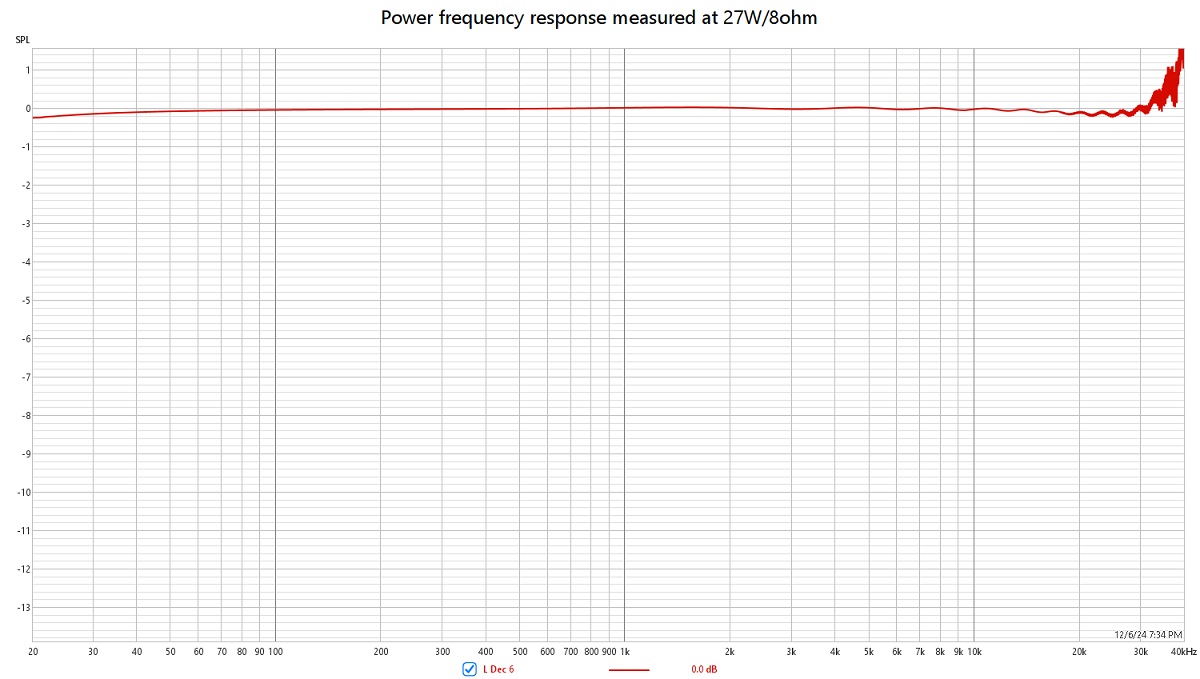
SMSL A100 amplifier review
This test review was performed to comply with FTC: 16 CFR Part 432 (July 5, 2024) - Power Output Claims for Amplifiers Utilized in Home Entertainment Products
The SMSL A100 is a small, affordable, 2-channel Class D amplifier. It embeds an Infeon MA-12070 amplifier chip and it has a built-in power supply (AC 100V-240V input), which is a nice feature. The inputs are in stereo RCA, USB-A and Bluetooth. I bought it from Amazon.de at price of 80.37 EUR with free shipping, so it is a bargain.
The amplifier works in the BTL mode and on any of the speaker binding posts (+ or -) there is +12.25Vdc against the signal common, which is at the body of RCA connectors. So be careful when measuring the amp, use properly rated coupling capacitors and differential input mode of the ADC. Another note - the amplifier is a class I instrument and its signal common is connected to the PE (middle pin of the mains plug). This may worsen S/N when connected to the class I signal source like class I DAC.


1. Manufacturer's specifications
Manufacturer's specifications are listed below

Frankly speaking, the specified output power seems quite high related to the chip used, so I rather attach specifications from the MA-12070 datasheet. The SMSL A100 implementation cannot have better power rating than the chip used, itself.
MA-12070 datasheet specifications

This is something I might believe so I will consider the continuous rated power to be 2 x 30W/8ohm/1kHz.
2. Test conditions
The amplifier was tested with the built-in power supply, 230Vac, and 8ohm load in both L and R channel. Testing with 4ohm load was done just as an orientation measurement, as the rated power to 4ohm is unknown.
3. Pre-conditioning
First of all, the amplifier was pre-conditioned at about 1/8 of the rated power, 2 x 4.2W/8ohm, for one hour, as requested by the FCT document. At the end of the pre-conditioning period, the amplifier case was only mildly warm. The distortion in the beginning and in the end of the pre-conditioning is shown below.
4. Frequency response
Frequency response was measured at 5W output power into 8ohm. The amplifier has filterless design, without output LC filter, so the frequency response is independent of load impedance.

5. Power frequency response measured at 27W/8ohm, to 40kHz

Power frequency response was estimated as 20Hz - 20kHz. Behaviour above 20kHz is a bit erratic.
6. Distortion was measured at volume pot set to maximum, G = 40dB
6.1. Distortion at 5W/8ohm

6.2. Distortion at 21W/8ohm

6.3. THD vs. output voltage into 8ohm load at 1kHz with measurement bandwidth 45kHz

Maximum power is 37W/1kHz/8ohm with THD = 10.5%

The amplifier meets the specs at 30W/1kHz/8ohm with THD<1%
6.4.1. THD vs. frequency at 5W/8ohm

There is a steep rise of THD above 1.5kHz and THD > 1% above 13kHz with measuring BW45kHz. All the high HF distortion components are in the ultrasonic range, above 20kHz.
6.4.2. THD vs. frequency at rated power 27W/8ohm with BW24kHz

THD is below 1% in the 20Hz - 12kHz range with measuring bandwidth 24kHz, as the ultrasonic distortion is omitted.
6.5. CCIF 19+20kHz intermodulation distortion at 10W/8ohm

The result is better than expected, beacuse the nasty distortion components are at ultrasonic fequencies.
6.6. 5 minutes test at rated (derated) power 2 x 27W/8ohm/1kHz
The amplifier has passed 5 minute test at 27W/8ohm/1kHz, being only mildly warm at the end of the test.

Further increasing of power resulted in distortion > 1% in the 5 minute test. But not to the shut down.
7. HF measurements
Below one can see the plot of amplifier common mode and differential output voltages (input driven by 10kHz sine) and spectrum extended to 3MHz.


Similar almost unchanged plots are measured behind the 2m of speaker cable:


WARNING! The amplifier is a source of electromagnetic interferences emitted from the speaker cables!
8. Conclusion
The amplifier is a mixture of good and bad points. Built quality is quite good, concerning the bargain price. It did not get hot during tests and never shut down itself. Frequency response does not have the infamous dependence on load impedance and response peaking above 10kHz, as it is a filterless design. However, this brings troubles in the field of electromagnetic interference. My wifi staying near was almost paralyzed. The DAC feeding the amp with test signals was unable to work without using USB-ISO isolator. For the 5 minute rated power test I had to use analog generator, as the DAC was freezing at amplifier high power due to emitted interference.
Manufacturer's specification of power is vague and unusable. So I rather used the specs from MA-12070 chip datasheet, that declares rated continuous power 30W/8ohm/1kHz per channel. This was almost fulfiled in the 5 minute test, the amplifier was able to do it at 27W with THD << 1%.
Pavel Macura 12/6/2024